A Study on How Personality Affects Physiological Stress Response
VerifiedAdded on 2022/09/17
|14
|1992
|38
Report
AI Summary
This report investigates the relationship between personality types (Type A and Type B) and stress response, based on Friedman and Rosenman's theory. A two-stage experiment was conducted, measuring the pulse rates of participants with Type A and Type B personalities during a stressful dot-to-dot puzzle activity. The results indicated that individuals with Type A personalities exhibited significantly higher pulse rates compared to those with Type B personalities, supporting the hypothesis that Type A personalities have a lower stress-handling capacity. Statistical analysis, including a t-test, confirmed the significant difference in pulse rates between the two groups, leading to the rejection of the null hypothesis. The study concludes that Type A individuals may be more prone to cardiovascular symptoms and general anxiety disorder due to their heightened stress response.

Running head: EFFECT OF PERSONALITY ON THE STRESS RESPONSE
An investigation to measure effect of personality on the stress response
Name of the Student
Name of the University
Author note
An investigation to measure effect of personality on the stress response
Name of the Student
Name of the University
Author note
Paraphrase This Document
Need a fresh take? Get an instant paraphrase of this document with our AI Paraphraser
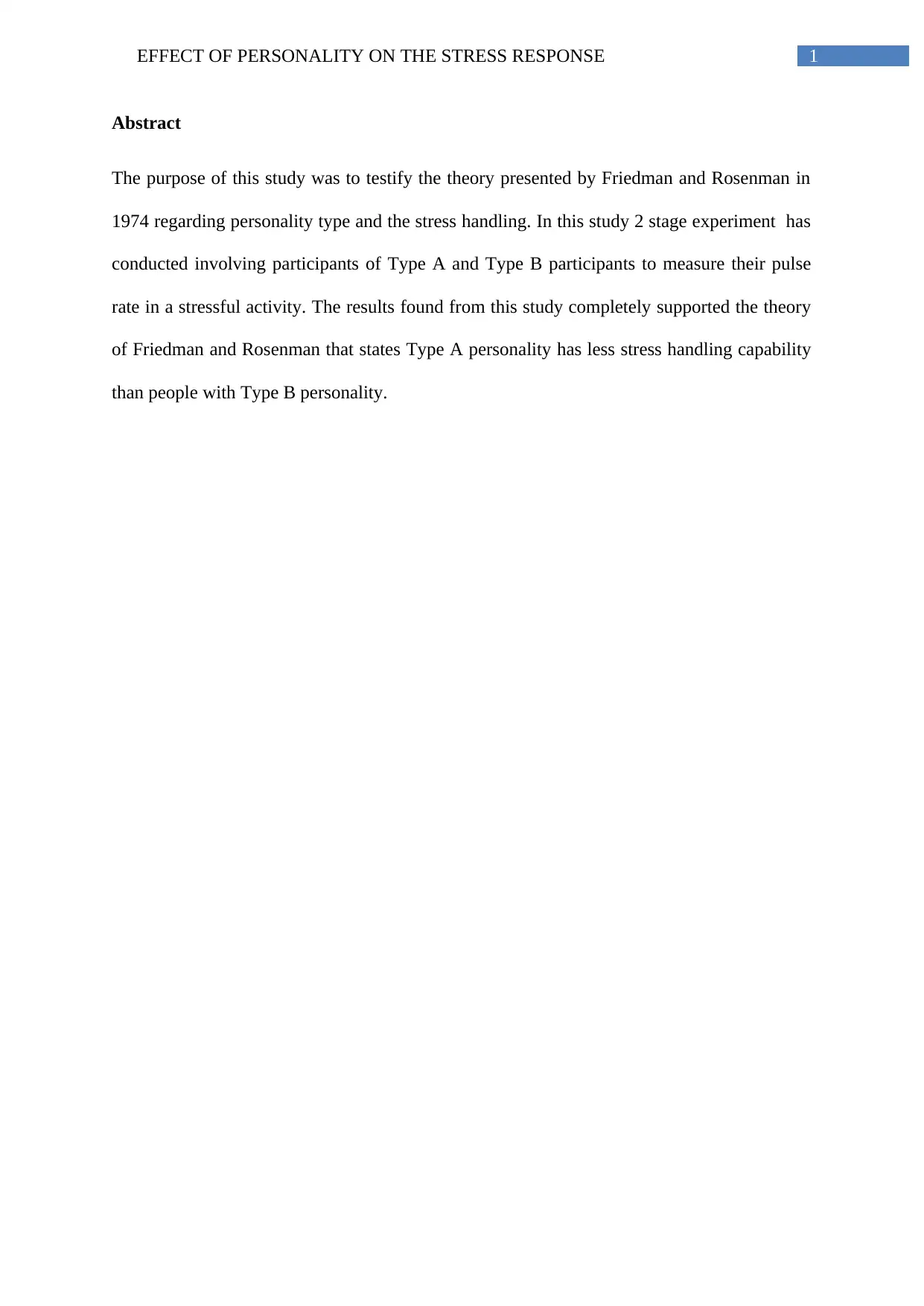
1EFFECT OF PERSONALITY ON THE STRESS RESPONSE
Abstract
The purpose of this study was to testify the theory presented by Friedman and Rosenman in
1974 regarding personality type and the stress handling. In this study 2 stage experiment has
conducted involving participants of Type A and Type B participants to measure their pulse
rate in a stressful activity. The results found from this study completely supported the theory
of Friedman and Rosenman that states Type A personality has less stress handling capability
than people with Type B personality.
Abstract
The purpose of this study was to testify the theory presented by Friedman and Rosenman in
1974 regarding personality type and the stress handling. In this study 2 stage experiment has
conducted involving participants of Type A and Type B participants to measure their pulse
rate in a stressful activity. The results found from this study completely supported the theory
of Friedman and Rosenman that states Type A personality has less stress handling capability
than people with Type B personality.
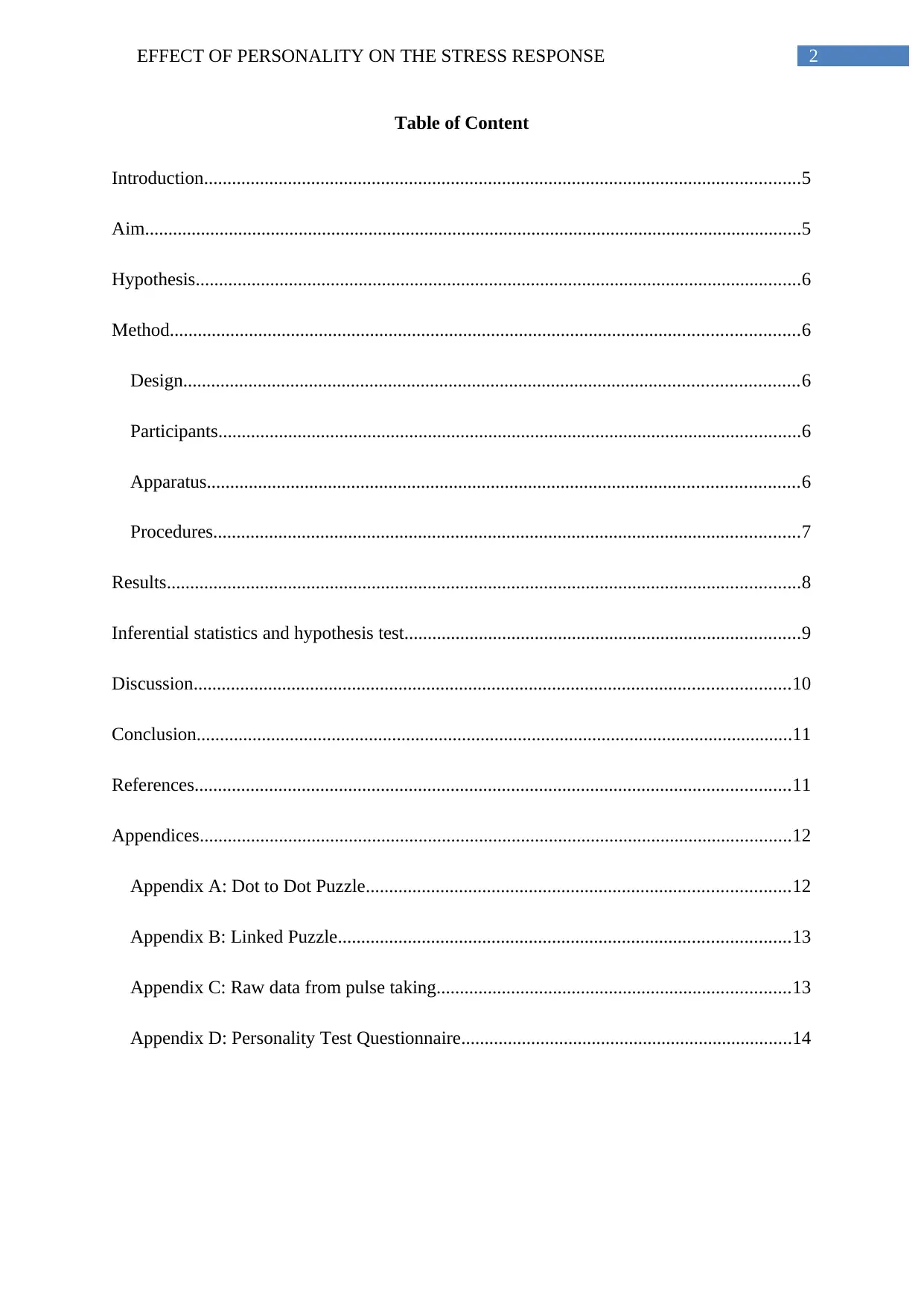
2EFFECT OF PERSONALITY ON THE STRESS RESPONSE
Table of Content
Introduction................................................................................................................................5
Aim.............................................................................................................................................5
Hypothesis..................................................................................................................................6
Method.......................................................................................................................................6
Design....................................................................................................................................6
Participants.............................................................................................................................6
Apparatus...............................................................................................................................6
Procedures..............................................................................................................................7
Results........................................................................................................................................8
Inferential statistics and hypothesis test.....................................................................................9
Discussion................................................................................................................................10
Conclusion................................................................................................................................11
References................................................................................................................................11
Appendices...............................................................................................................................12
Appendix A: Dot to Dot Puzzle...........................................................................................12
Appendix B: Linked Puzzle.................................................................................................13
Appendix C: Raw data from pulse taking............................................................................13
Appendix D: Personality Test Questionnaire.......................................................................14
Table of Content
Introduction................................................................................................................................5
Aim.............................................................................................................................................5
Hypothesis..................................................................................................................................6
Method.......................................................................................................................................6
Design....................................................................................................................................6
Participants.............................................................................................................................6
Apparatus...............................................................................................................................6
Procedures..............................................................................................................................7
Results........................................................................................................................................8
Inferential statistics and hypothesis test.....................................................................................9
Discussion................................................................................................................................10
Conclusion................................................................................................................................11
References................................................................................................................................11
Appendices...............................................................................................................................12
Appendix A: Dot to Dot Puzzle...........................................................................................12
Appendix B: Linked Puzzle.................................................................................................13
Appendix C: Raw data from pulse taking............................................................................13
Appendix D: Personality Test Questionnaire.......................................................................14
⊘ This is a preview!⊘
Do you want full access?
Subscribe today to unlock all pages.

Trusted by 1+ million students worldwide
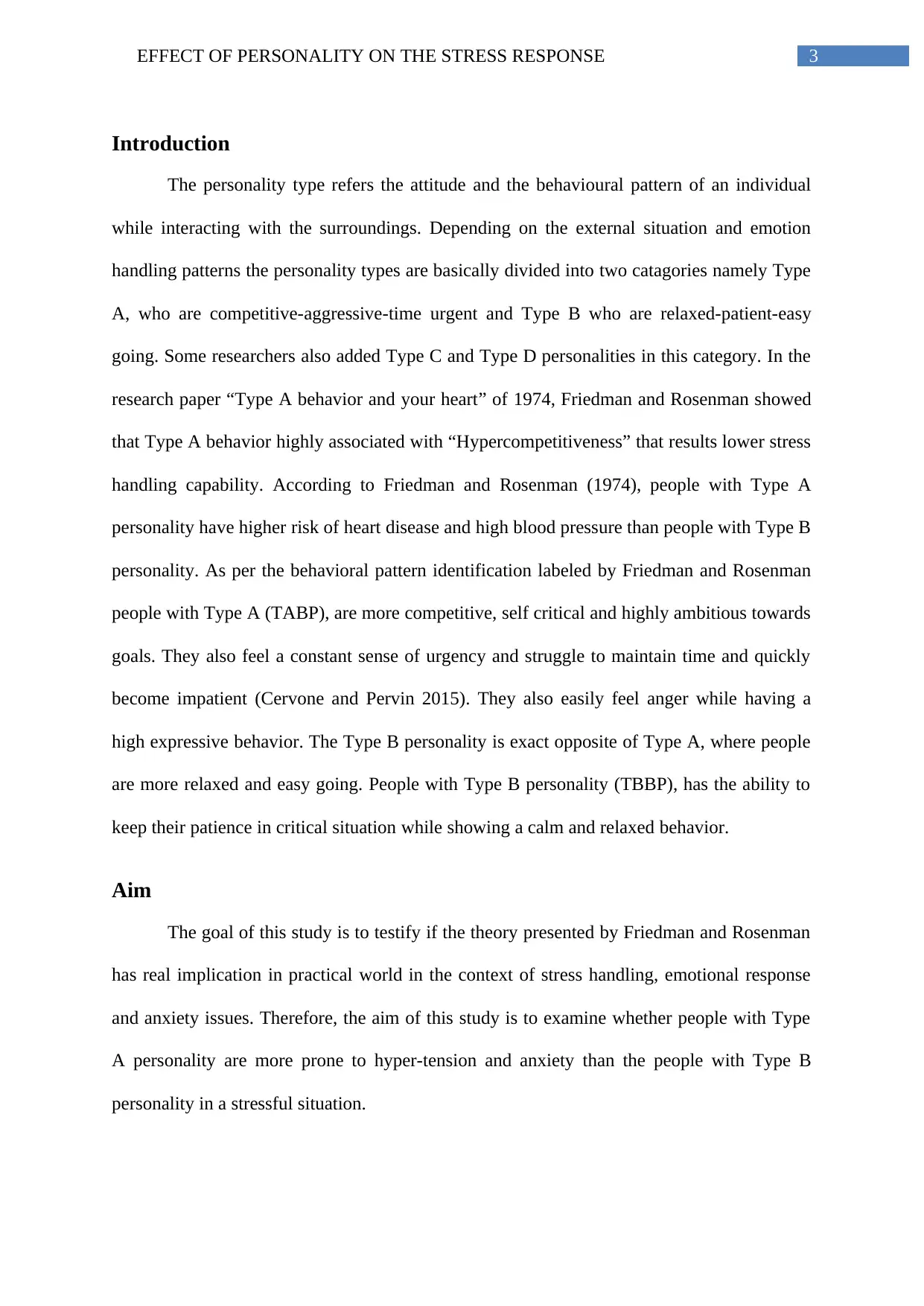
3EFFECT OF PERSONALITY ON THE STRESS RESPONSE
Introduction
The personality type refers the attitude and the behavioural pattern of an individual
while interacting with the surroundings. Depending on the external situation and emotion
handling patterns the personality types are basically divided into two catagories namely Type
A, who are competitive-aggressive-time urgent and Type B who are relaxed-patient-easy
going. Some researchers also added Type C and Type D personalities in this category. In the
research paper “Type A behavior and your heart” of 1974, Friedman and Rosenman showed
that Type A behavior highly associated with “Hypercompetitiveness” that results lower stress
handling capability. According to Friedman and Rosenman (1974), people with Type A
personality have higher risk of heart disease and high blood pressure than people with Type B
personality. As per the behavioral pattern identification labeled by Friedman and Rosenman
people with Type A (TABP), are more competitive, self critical and highly ambitious towards
goals. They also feel a constant sense of urgency and struggle to maintain time and quickly
become impatient (Cervone and Pervin 2015). They also easily feel anger while having a
high expressive behavior. The Type B personality is exact opposite of Type A, where people
are more relaxed and easy going. People with Type B personality (TBBP), has the ability to
keep their patience in critical situation while showing a calm and relaxed behavior.
Aim
The goal of this study is to testify if the theory presented by Friedman and Rosenman
has real implication in practical world in the context of stress handling, emotional response
and anxiety issues. Therefore, the aim of this study is to examine whether people with Type
A personality are more prone to hyper-tension and anxiety than the people with Type B
personality in a stressful situation.
Introduction
The personality type refers the attitude and the behavioural pattern of an individual
while interacting with the surroundings. Depending on the external situation and emotion
handling patterns the personality types are basically divided into two catagories namely Type
A, who are competitive-aggressive-time urgent and Type B who are relaxed-patient-easy
going. Some researchers also added Type C and Type D personalities in this category. In the
research paper “Type A behavior and your heart” of 1974, Friedman and Rosenman showed
that Type A behavior highly associated with “Hypercompetitiveness” that results lower stress
handling capability. According to Friedman and Rosenman (1974), people with Type A
personality have higher risk of heart disease and high blood pressure than people with Type B
personality. As per the behavioral pattern identification labeled by Friedman and Rosenman
people with Type A (TABP), are more competitive, self critical and highly ambitious towards
goals. They also feel a constant sense of urgency and struggle to maintain time and quickly
become impatient (Cervone and Pervin 2015). They also easily feel anger while having a
high expressive behavior. The Type B personality is exact opposite of Type A, where people
are more relaxed and easy going. People with Type B personality (TBBP), has the ability to
keep their patience in critical situation while showing a calm and relaxed behavior.
Aim
The goal of this study is to testify if the theory presented by Friedman and Rosenman
has real implication in practical world in the context of stress handling, emotional response
and anxiety issues. Therefore, the aim of this study is to examine whether people with Type
A personality are more prone to hyper-tension and anxiety than the people with Type B
personality in a stressful situation.
Paraphrase This Document
Need a fresh take? Get an instant paraphrase of this document with our AI Paraphraser
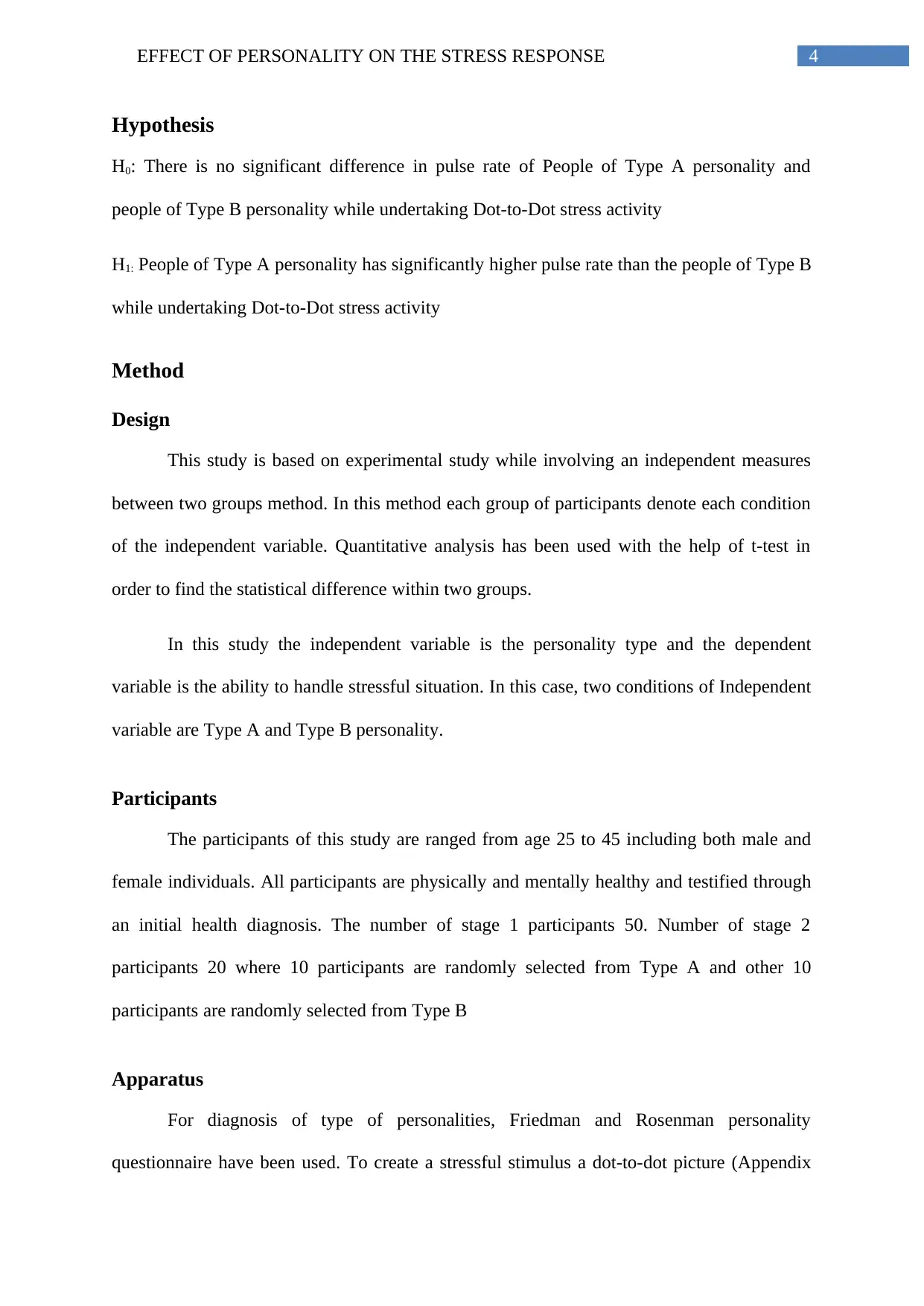
4EFFECT OF PERSONALITY ON THE STRESS RESPONSE
Hypothesis
H0: There is no significant difference in pulse rate of People of Type A personality and
people of Type B personality while undertaking Dot-to-Dot stress activity
H1: People of Type A personality has significantly higher pulse rate than the people of Type B
while undertaking Dot-to-Dot stress activity
Method
Design
This study is based on experimental study while involving an independent measures
between two groups method. In this method each group of participants denote each condition
of the independent variable. Quantitative analysis has been used with the help of t-test in
order to find the statistical difference within two groups.
In this study the independent variable is the personality type and the dependent
variable is the ability to handle stressful situation. In this case, two conditions of Independent
variable are Type A and Type B personality.
Participants
The participants of this study are ranged from age 25 to 45 including both male and
female individuals. All participants are physically and mentally healthy and testified through
an initial health diagnosis. The number of stage 1 participants 50. Number of stage 2
participants 20 where 10 participants are randomly selected from Type A and other 10
participants are randomly selected from Type B
Apparatus
For diagnosis of type of personalities, Friedman and Rosenman personality
questionnaire have been used. To create a stressful stimulus a dot-to-dot picture (Appendix
Hypothesis
H0: There is no significant difference in pulse rate of People of Type A personality and
people of Type B personality while undertaking Dot-to-Dot stress activity
H1: People of Type A personality has significantly higher pulse rate than the people of Type B
while undertaking Dot-to-Dot stress activity
Method
Design
This study is based on experimental study while involving an independent measures
between two groups method. In this method each group of participants denote each condition
of the independent variable. Quantitative analysis has been used with the help of t-test in
order to find the statistical difference within two groups.
In this study the independent variable is the personality type and the dependent
variable is the ability to handle stressful situation. In this case, two conditions of Independent
variable are Type A and Type B personality.
Participants
The participants of this study are ranged from age 25 to 45 including both male and
female individuals. All participants are physically and mentally healthy and testified through
an initial health diagnosis. The number of stage 1 participants 50. Number of stage 2
participants 20 where 10 participants are randomly selected from Type A and other 10
participants are randomly selected from Type B
Apparatus
For diagnosis of type of personalities, Friedman and Rosenman personality
questionnaire have been used. To create a stressful stimulus a dot-to-dot picture (Appendix
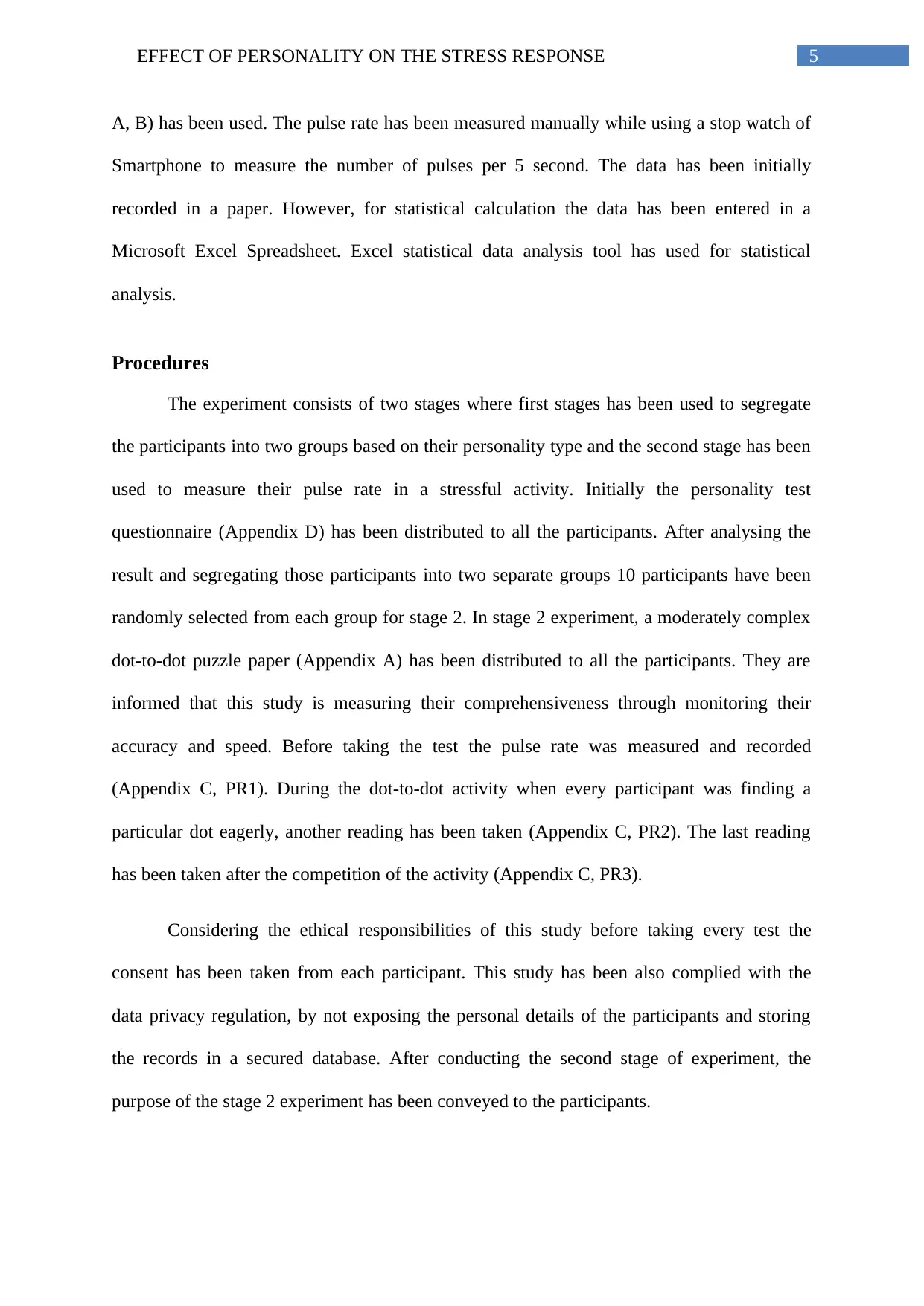
5EFFECT OF PERSONALITY ON THE STRESS RESPONSE
A, B) has been used. The pulse rate has been measured manually while using a stop watch of
Smartphone to measure the number of pulses per 5 second. The data has been initially
recorded in a paper. However, for statistical calculation the data has been entered in a
Microsoft Excel Spreadsheet. Excel statistical data analysis tool has used for statistical
analysis.
Procedures
The experiment consists of two stages where first stages has been used to segregate
the participants into two groups based on their personality type and the second stage has been
used to measure their pulse rate in a stressful activity. Initially the personality test
questionnaire (Appendix D) has been distributed to all the participants. After analysing the
result and segregating those participants into two separate groups 10 participants have been
randomly selected from each group for stage 2. In stage 2 experiment, a moderately complex
dot-to-dot puzzle paper (Appendix A) has been distributed to all the participants. They are
informed that this study is measuring their comprehensiveness through monitoring their
accuracy and speed. Before taking the test the pulse rate was measured and recorded
(Appendix C, PR1). During the dot-to-dot activity when every participant was finding a
particular dot eagerly, another reading has been taken (Appendix C, PR2). The last reading
has been taken after the competition of the activity (Appendix C, PR3).
Considering the ethical responsibilities of this study before taking every test the
consent has been taken from each participant. This study has been also complied with the
data privacy regulation, by not exposing the personal details of the participants and storing
the records in a secured database. After conducting the second stage of experiment, the
purpose of the stage 2 experiment has been conveyed to the participants.
A, B) has been used. The pulse rate has been measured manually while using a stop watch of
Smartphone to measure the number of pulses per 5 second. The data has been initially
recorded in a paper. However, for statistical calculation the data has been entered in a
Microsoft Excel Spreadsheet. Excel statistical data analysis tool has used for statistical
analysis.
Procedures
The experiment consists of two stages where first stages has been used to segregate
the participants into two groups based on their personality type and the second stage has been
used to measure their pulse rate in a stressful activity. Initially the personality test
questionnaire (Appendix D) has been distributed to all the participants. After analysing the
result and segregating those participants into two separate groups 10 participants have been
randomly selected from each group for stage 2. In stage 2 experiment, a moderately complex
dot-to-dot puzzle paper (Appendix A) has been distributed to all the participants. They are
informed that this study is measuring their comprehensiveness through monitoring their
accuracy and speed. Before taking the test the pulse rate was measured and recorded
(Appendix C, PR1). During the dot-to-dot activity when every participant was finding a
particular dot eagerly, another reading has been taken (Appendix C, PR2). The last reading
has been taken after the competition of the activity (Appendix C, PR3).
Considering the ethical responsibilities of this study before taking every test the
consent has been taken from each participant. This study has been also complied with the
data privacy regulation, by not exposing the personal details of the participants and storing
the records in a secured database. After conducting the second stage of experiment, the
purpose of the stage 2 experiment has been conveyed to the participants.
⊘ This is a preview!⊘
Do you want full access?
Subscribe today to unlock all pages.

Trusted by 1+ million students worldwide
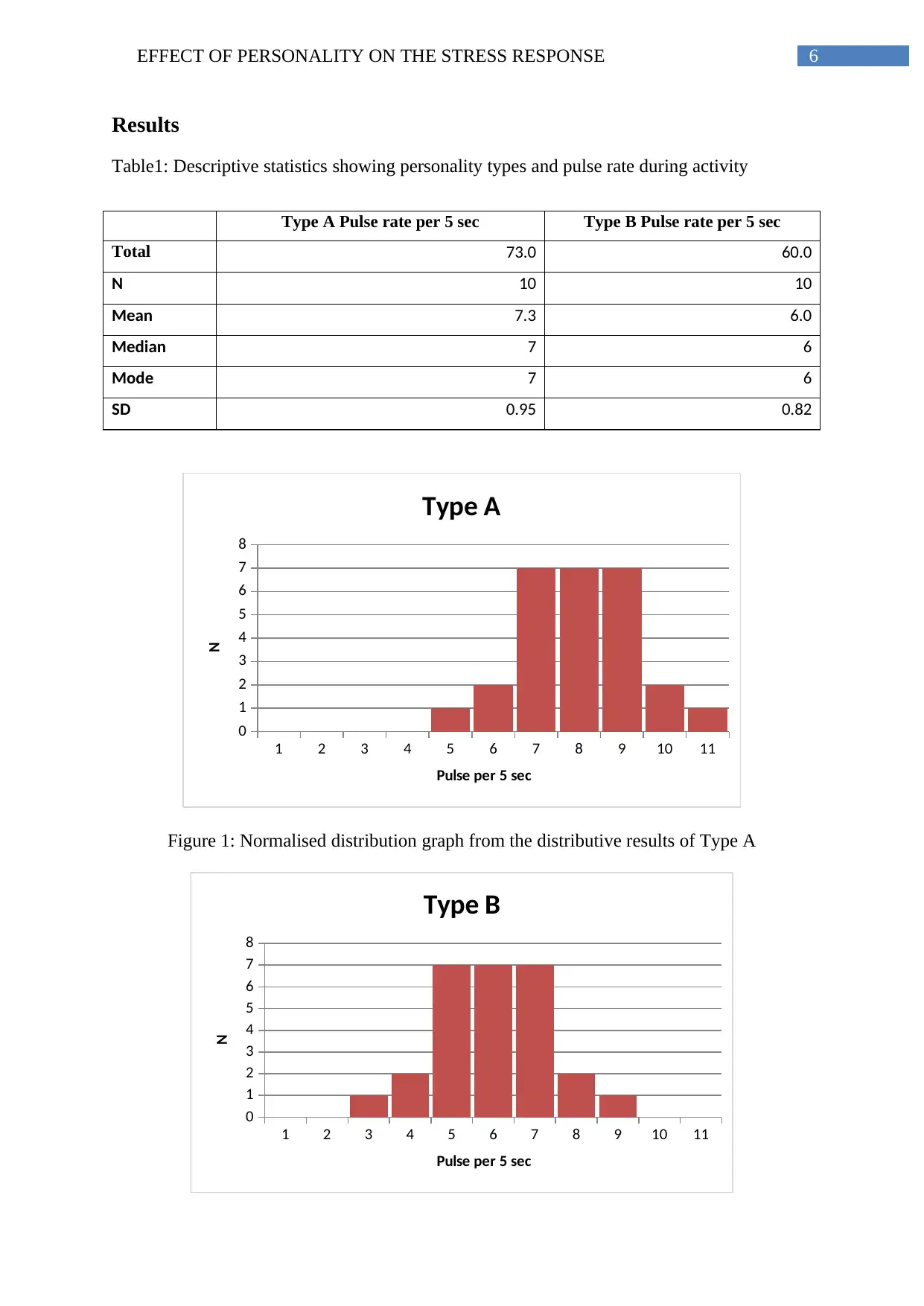
6EFFECT OF PERSONALITY ON THE STRESS RESPONSE
Results
Table1: Descriptive statistics showing personality types and pulse rate during activity
Type A Pulse rate per 5 sec Type B Pulse rate per 5 sec
Total 73.0 60.0
N 10 10
Mean 7.3 6.0
Median 7 6
Mode 7 6
SD 0.95 0.82
1 2 3 4 5 6 7 8 9 10 11
0
1
2
3
4
5
6
7
8
Type A
Pulse per 5 sec
N
Figure 1: Normalised distribution graph from the distributive results of Type A
1 2 3 4 5 6 7 8 9 10 11
0
1
2
3
4
5
6
7
8
Type B
Pulse per 5 sec
N
Results
Table1: Descriptive statistics showing personality types and pulse rate during activity
Type A Pulse rate per 5 sec Type B Pulse rate per 5 sec
Total 73.0 60.0
N 10 10
Mean 7.3 6.0
Median 7 6
Mode 7 6
SD 0.95 0.82
1 2 3 4 5 6 7 8 9 10 11
0
1
2
3
4
5
6
7
8
Type A
Pulse per 5 sec
N
Figure 1: Normalised distribution graph from the distributive results of Type A
1 2 3 4 5 6 7 8 9 10 11
0
1
2
3
4
5
6
7
8
Type B
Pulse per 5 sec
N
Paraphrase This Document
Need a fresh take? Get an instant paraphrase of this document with our AI Paraphraser
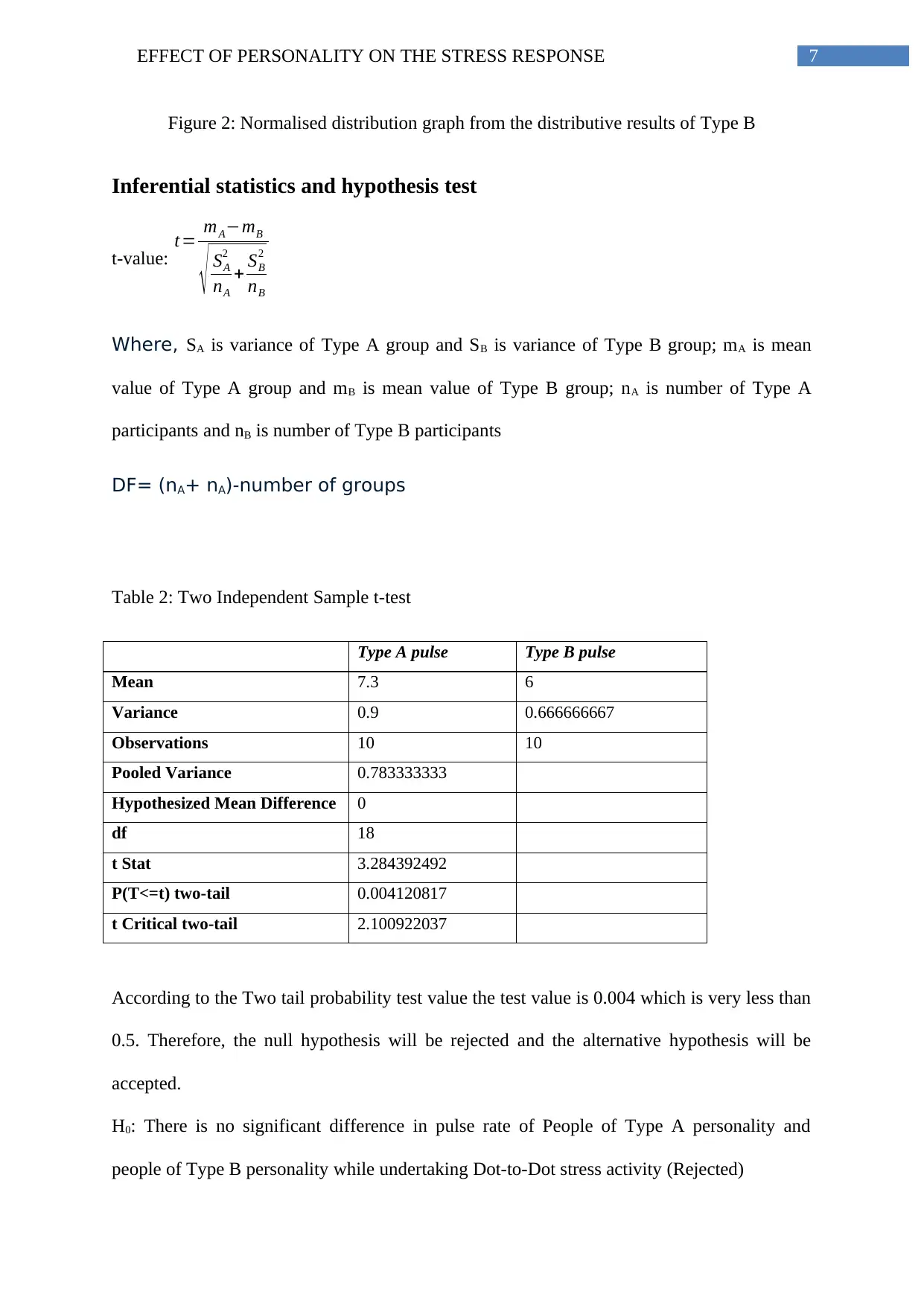
7EFFECT OF PERSONALITY ON THE STRESS RESPONSE
Figure 2: Normalised distribution graph from the distributive results of Type B
Inferential statistics and hypothesis test
t-value: t= mA−mB
√ SA
2
nA
+ SB
2
nB
Where, SA is variance of Type A group and SB is variance of Type B group; mA is mean
value of Type A group and mB is mean value of Type B group; nA is number of Type A
participants and nB is number of Type B participants
DF= (nA+ nA)-number of groups
Table 2: Two Independent Sample t-test
Type A pulse Type B pulse
Mean 7.3 6
Variance 0.9 0.666666667
Observations 10 10
Pooled Variance 0.783333333
Hypothesized Mean Difference 0
df 18
t Stat 3.284392492
P(T<=t) two-tail 0.004120817
t Critical two-tail 2.100922037
According to the Two tail probability test value the test value is 0.004 which is very less than
0.5. Therefore, the null hypothesis will be rejected and the alternative hypothesis will be
accepted.
H0: There is no significant difference in pulse rate of People of Type A personality and
people of Type B personality while undertaking Dot-to-Dot stress activity (Rejected)
Figure 2: Normalised distribution graph from the distributive results of Type B
Inferential statistics and hypothesis test
t-value: t= mA−mB
√ SA
2
nA
+ SB
2
nB
Where, SA is variance of Type A group and SB is variance of Type B group; mA is mean
value of Type A group and mB is mean value of Type B group; nA is number of Type A
participants and nB is number of Type B participants
DF= (nA+ nA)-number of groups
Table 2: Two Independent Sample t-test
Type A pulse Type B pulse
Mean 7.3 6
Variance 0.9 0.666666667
Observations 10 10
Pooled Variance 0.783333333
Hypothesized Mean Difference 0
df 18
t Stat 3.284392492
P(T<=t) two-tail 0.004120817
t Critical two-tail 2.100922037
According to the Two tail probability test value the test value is 0.004 which is very less than
0.5. Therefore, the null hypothesis will be rejected and the alternative hypothesis will be
accepted.
H0: There is no significant difference in pulse rate of People of Type A personality and
people of Type B personality while undertaking Dot-to-Dot stress activity (Rejected)

8EFFECT OF PERSONALITY ON THE STRESS RESPONSE
H1: People of Type A personality has significantly higher pulse rate than the people of Type B
while undertaking Dot-to-Dot stress activity (Accepted)
Discussion
Therefore, from the hypothesis test it can be clearly understood that People of Type A
personality has significantly higher pulse rate than the people of Type B while undertaking
the stress activity. It implies that people with Type A personality are more prone to take
stress and become anxious than the people with Type B personality (Miličić et al. 2016). As
per the theory of Friedman and Rosenman, people with Type A personality have less ability
to handle stressed situation and are prone to cardio-vascular symptoms. On the other hand,
the results found in this study imply that people with Type A personality are prone to
increased heart rate or pulse rate in a stressed situation. This increased heart rate can also
result cardio-vascular symptoms. Therefore, the results of this experiment conducted in this
study clearly supports the theory presented by Friedman and Rosenman in 1974 named “Type
A behavior and your heart” of 1974.
From this study it can be also stated that people with type A personality have less
stress handling capacity where the chances of becoming hyper-active, experiencing hyper-
tension and anxiety are higher than Type B. Therefore, people with type A personality should
be more couscous about their likeness of having cardio-vascular symptom and GAD (General
Anxiety Disorder) issues (Du et al. 2016).
Conclusion
The purpose of this study was to testify the theory presented by Friedman and
Rosenman in 1974 regarding personality type and the stress handling. Hence, this study
conducted 2 stage experiment involving Type A group and Type B group participants while
measuring their pulse rate in a stressful activity. The results of this experiment completely
H1: People of Type A personality has significantly higher pulse rate than the people of Type B
while undertaking Dot-to-Dot stress activity (Accepted)
Discussion
Therefore, from the hypothesis test it can be clearly understood that People of Type A
personality has significantly higher pulse rate than the people of Type B while undertaking
the stress activity. It implies that people with Type A personality are more prone to take
stress and become anxious than the people with Type B personality (Miličić et al. 2016). As
per the theory of Friedman and Rosenman, people with Type A personality have less ability
to handle stressed situation and are prone to cardio-vascular symptoms. On the other hand,
the results found in this study imply that people with Type A personality are prone to
increased heart rate or pulse rate in a stressed situation. This increased heart rate can also
result cardio-vascular symptoms. Therefore, the results of this experiment conducted in this
study clearly supports the theory presented by Friedman and Rosenman in 1974 named “Type
A behavior and your heart” of 1974.
From this study it can be also stated that people with type A personality have less
stress handling capacity where the chances of becoming hyper-active, experiencing hyper-
tension and anxiety are higher than Type B. Therefore, people with type A personality should
be more couscous about their likeness of having cardio-vascular symptom and GAD (General
Anxiety Disorder) issues (Du et al. 2016).
Conclusion
The purpose of this study was to testify the theory presented by Friedman and
Rosenman in 1974 regarding personality type and the stress handling. Hence, this study
conducted 2 stage experiment involving Type A group and Type B group participants while
measuring their pulse rate in a stressful activity. The results of this experiment completely
⊘ This is a preview!⊘
Do you want full access?
Subscribe today to unlock all pages.

Trusted by 1+ million students worldwide
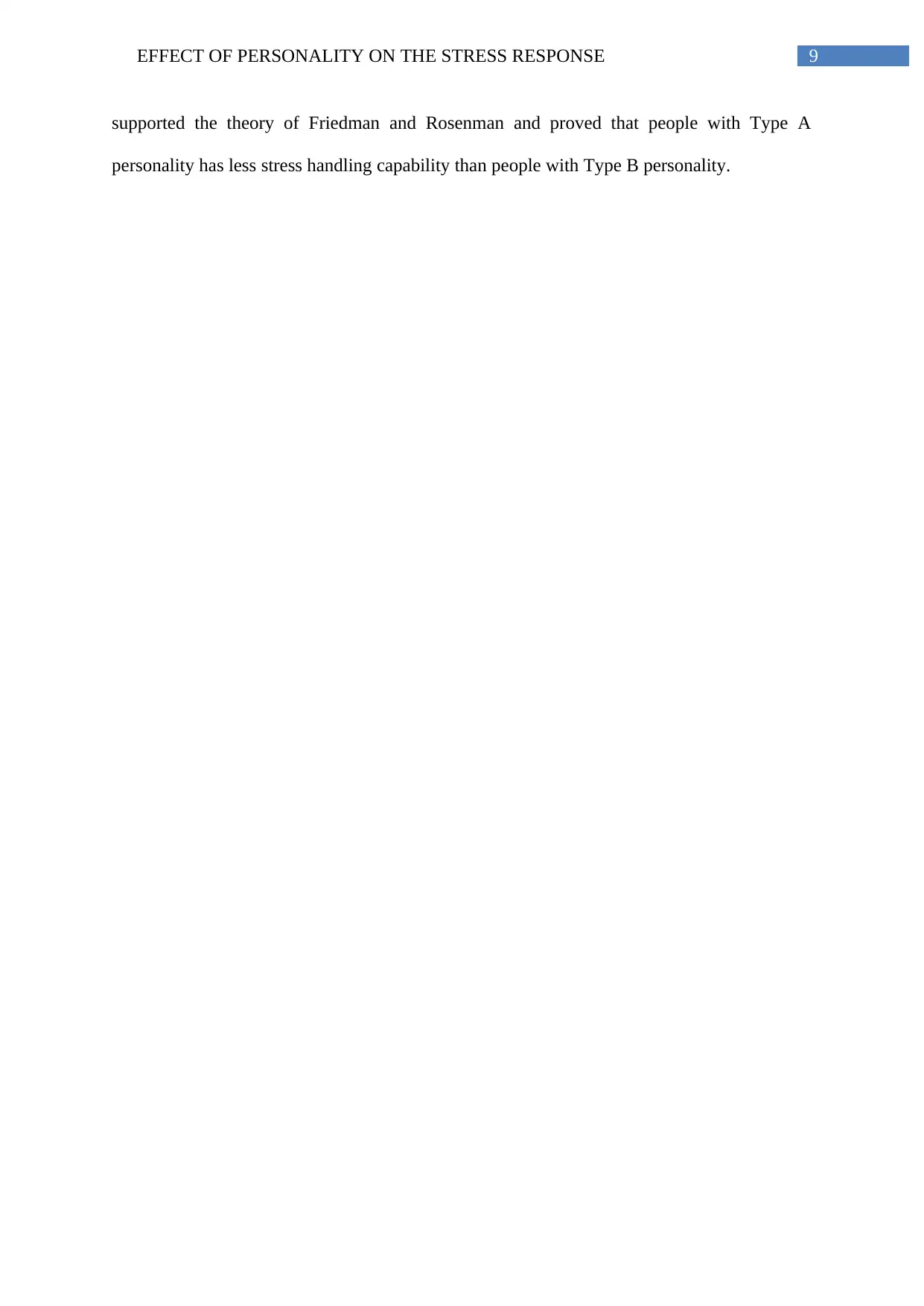
9EFFECT OF PERSONALITY ON THE STRESS RESPONSE
supported the theory of Friedman and Rosenman and proved that people with Type A
personality has less stress handling capability than people with Type B personality.
supported the theory of Friedman and Rosenman and proved that people with Type A
personality has less stress handling capability than people with Type B personality.
Paraphrase This Document
Need a fresh take? Get an instant paraphrase of this document with our AI Paraphraser
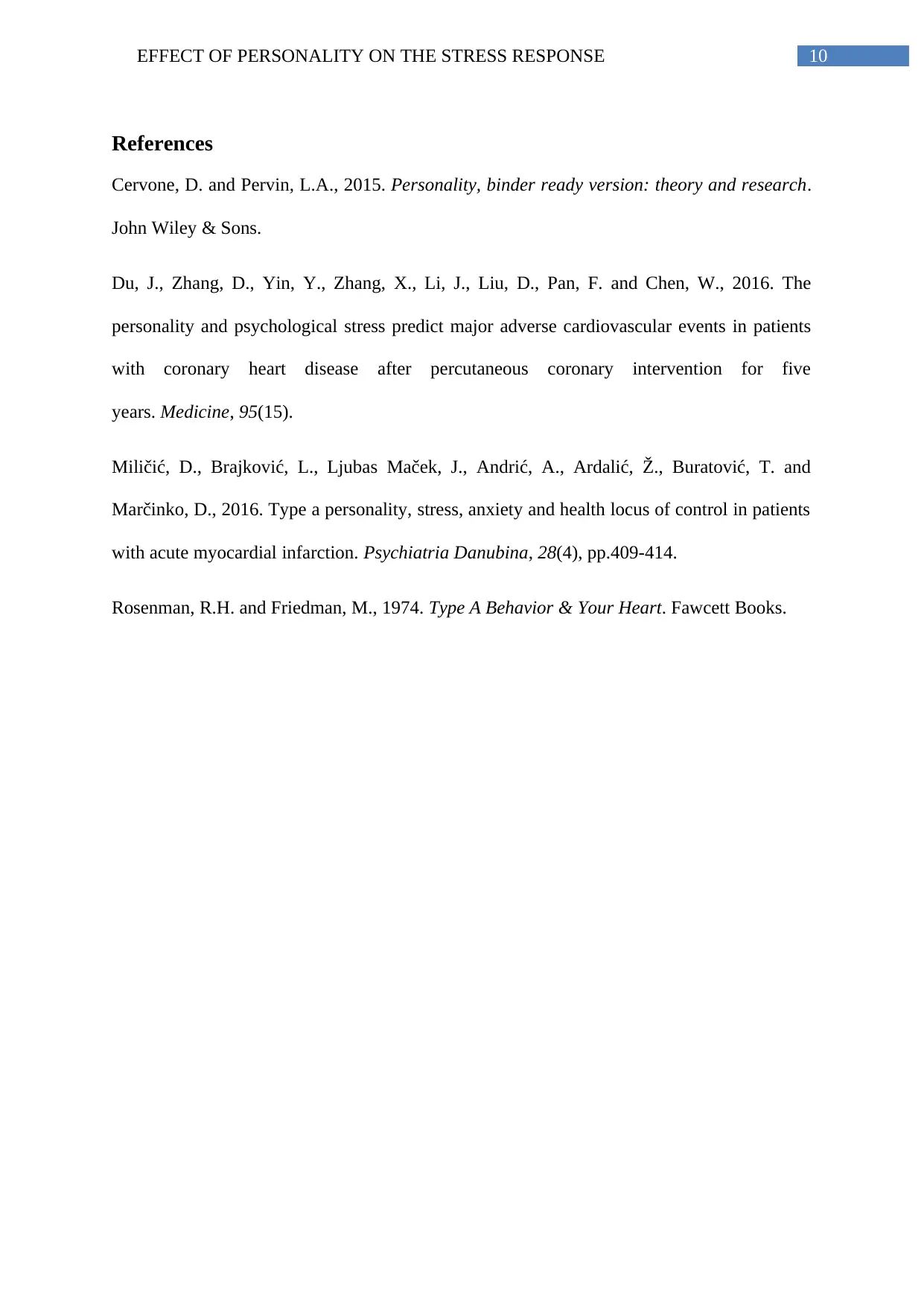
10EFFECT OF PERSONALITY ON THE STRESS RESPONSE
References
Cervone, D. and Pervin, L.A., 2015. Personality, binder ready version: theory and research.
John Wiley & Sons.
Du, J., Zhang, D., Yin, Y., Zhang, X., Li, J., Liu, D., Pan, F. and Chen, W., 2016. The
personality and psychological stress predict major adverse cardiovascular events in patients
with coronary heart disease after percutaneous coronary intervention for five
years. Medicine, 95(15).
Miličić, D., Brajković, L., Ljubas Maček, J., Andrić, A., Ardalić, Ž., Buratović, T. and
Marčinko, D., 2016. Type a personality, stress, anxiety and health locus of control in patients
with acute myocardial infarction. Psychiatria Danubina, 28(4), pp.409-414.
Rosenman, R.H. and Friedman, M., 1974. Type A Behavior & Your Heart. Fawcett Books.
References
Cervone, D. and Pervin, L.A., 2015. Personality, binder ready version: theory and research.
John Wiley & Sons.
Du, J., Zhang, D., Yin, Y., Zhang, X., Li, J., Liu, D., Pan, F. and Chen, W., 2016. The
personality and psychological stress predict major adverse cardiovascular events in patients
with coronary heart disease after percutaneous coronary intervention for five
years. Medicine, 95(15).
Miličić, D., Brajković, L., Ljubas Maček, J., Andrić, A., Ardalić, Ž., Buratović, T. and
Marčinko, D., 2016. Type a personality, stress, anxiety and health locus of control in patients
with acute myocardial infarction. Psychiatria Danubina, 28(4), pp.409-414.
Rosenman, R.H. and Friedman, M., 1974. Type A Behavior & Your Heart. Fawcett Books.
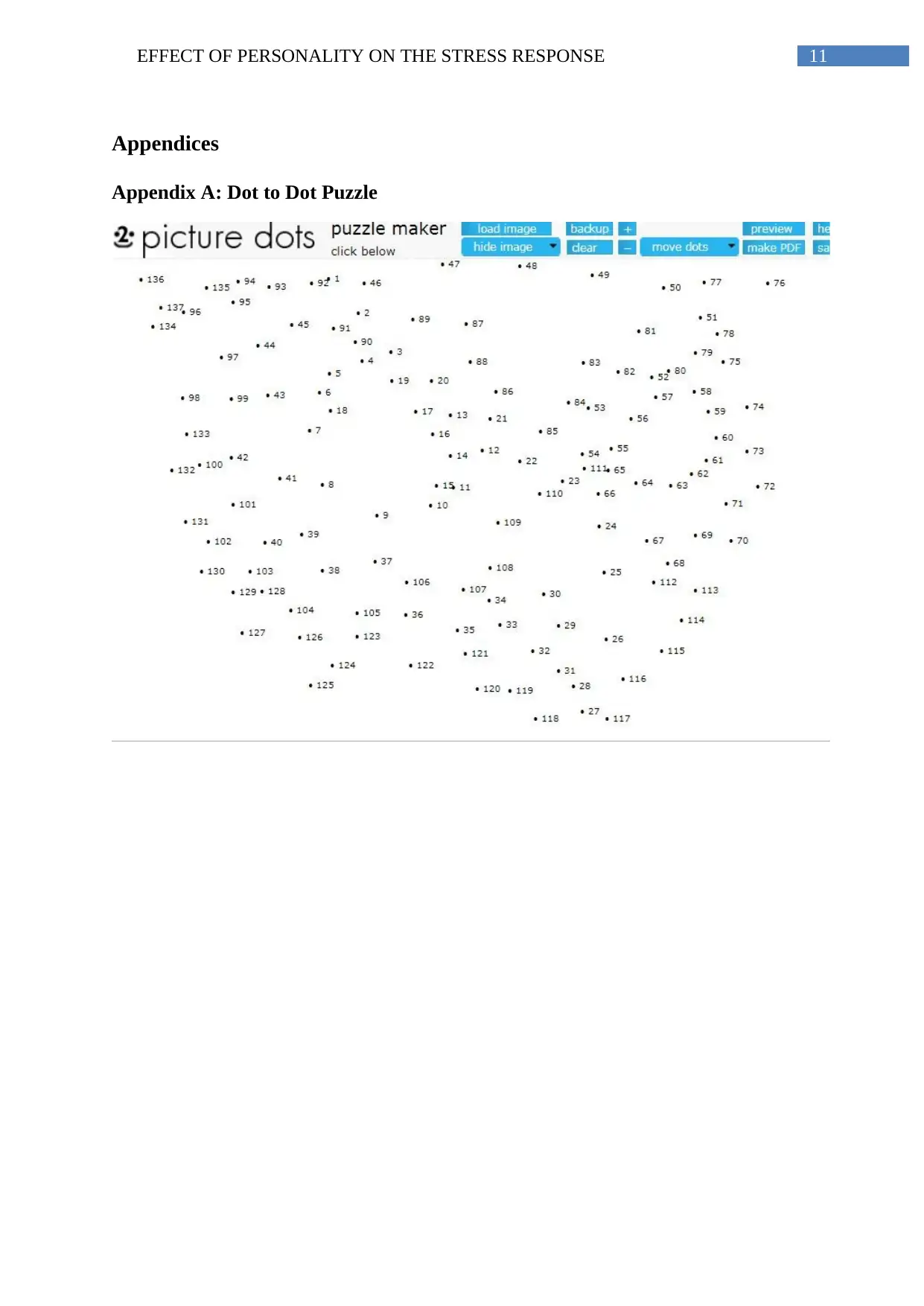
11EFFECT OF PERSONALITY ON THE STRESS RESPONSE
Appendices
Appendix A: Dot to Dot Puzzle
Appendices
Appendix A: Dot to Dot Puzzle
⊘ This is a preview!⊘
Do you want full access?
Subscribe today to unlock all pages.

Trusted by 1+ million students worldwide
1 out of 14
Related Documents
Your All-in-One AI-Powered Toolkit for Academic Success.
+13062052269
info@desklib.com
Available 24*7 on WhatsApp / Email
![[object Object]](/_next/static/media/star-bottom.7253800d.svg)
Unlock your academic potential
Copyright © 2020–2025 A2Z Services. All Rights Reserved. Developed and managed by ZUCOL.




